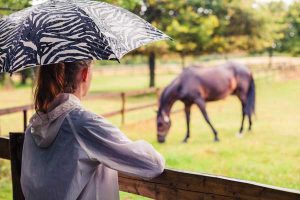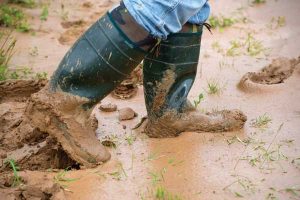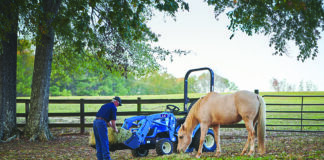
Winter horse keeping can be a real pain in the neck, no matter where you live and what challenges come with your climate. Whether your winter weather is cold, snowy, rainy, icy, or even balmy, here are tips and hacks from fellow horse people to make your horse care and riding more enjoyable and get your horse through winter.
Snow Belt

Lower-Maintenance Blanketing
When healthy horses are allowed to grow a good winter coat, they’re often comfortable, even in freezing temperatures.
“As a hunter/jumper trainer, I was an avid blanketer and used to run around changing horse clothes all day long,” she says. “One winter when I was pregnant, I didn’t blanket and was shocked at how well the horses did when allowed to regulate their own body temperatures.”
There are times, though, when blanketing is a good idea: for senior horses, for those that tend to lose weight or are new to a cold environment, and for extreme weather. If you blanket, be sure to use a waterproof turnout, as these are designed for rugged, outdoor use.

Feed More Hay
Feeding additional grass hay (not alfalfa) has multiple benefits. It keeps horses warm, helps them maintain weight and facilitates a healthy digestive system.
“I feed more hay than my horses need when it’s bitter cold,” says Alsberg. “When I see a tiny bit of hay left over at the next feeding, I know my horses had access all day or all night, and it helped them stay warm.”
Maintain Access to Fresh Water
Providing unfrozen water in freezing weather is essential to a horse’s health—and a big challenge. Without enough water, horses are prone to colic and other health risk.
“Most of my water tanks don’t have heaters,” says Alsberg. She hasn’t installed automatic waterers because she prefers to be able to monitor how much her horses are drinking.
“Each morning and evening, I break a basketball-sized hole in the ice in each tank,” she says. “I’ve found that the horses have access to water longer than if I break up all the ice and it refreezes. Plus, I haven’t seen that the horses drink more or less depending on the temperature of the water.”
She also adds a dash of salt to her horses’ grain rations to encourage them to drink adequate amounts of water.
Provide Room to Move and Shelter
Horses are meant to walk around all day, and frequent movement helps them generate body heat and also helps with digestion. If possible, let your horse live outside in a run, paddock or pasture with access to shelter from the wind.
“More than the cold, it’s the wind that’s the worst element for horses in the winter,” says Alsberg. “This is especially true if it’s wet and windy. If horses have a place to get out of the wind, their coat can dry and insulate them better.”
Get Yourself a Headlamp
Winter days are long and dark, and many horse chores happen before sunrise and after sunset.
“I can’t live without my headlamp,” says Alsberg. “It’s a great way to keep my hands free while I’m doing any sort of outdoor horse care.

Rainy Season
Michelle Hinds grew up with rainy, snowy, icy winters, and she later worked at dressage and eventing barns where the horses were mostly kept outdoors in pastures and paddocks in parts of the country with heavy rain all winter. If you live in the Southeast or Southwestern U.S., winter weather is basically the rainy season.
“As the British say, ‘If you don’t ride in the rain, then you don’t ride!’” she says, summing up how it feels to have horses in rainy areas like New England. “You learn to grin and bear it—and do things anyway.”
Gear Up
In wet weather especially, choosing the right gear is essential.
“A great waterproof riding raincoat makes all the difference,” Hinds says.
Also important are good gloves that maintain grip and stay warm when wet. Waterproof riding pants and quarter sheets help keep horse and rider warmer when riding outside.”
“Tall muck boots are essential for a few reasons,” she adds. “They keep your feet dry, can double as riding boots when it’s raining, and they won’t get sucked off in deep mud like paddock boots will.”
Hoof Traction
When wet footing and trails freeze, they become treacherous.
“One way to ride during the winter is to work with your farrier to apply studs or other traction devices if your horse is shod,” says Hinds.
Unshod horses can wear boots designed to provide traction.
Horses are meant to walk around all day, and frequent movement helps them generate body heat and also helps with digestion. If possible, let your horse live outside in a run, paddock or pasture with access to shelter from the wind.

Get Ready for Mud
Horses that live outdoors in rainy areas will be living in mud; it’s inevitable. Even if humans create a dry area and shelter for horses to use, often they’ll choose to be out in the rain and mud anyway.
Having rain gutters that divert water away from the barn will help, as will building the barn on land with a slight slope or at a high point rather than in a low spot.
“But no matter how much sand we bring into a paddock, with enough water, it will become deep muck,” says Hinds.
Instead of trying to fight it, do the best you can. For example, clean out hooves every day and apply thrush products when necessary. Groom regularly to help prevent rain rot and other skin conditions.

“Some horses will be happier living inside, while others will want to be turned out no matter what the weather,” she says. “When we can allow our horses choices, they’ll generally be happier and healthier.”
By implementing a few hacks and tips, you and your horse can survive—and even thrive—no matter what winter throws your way.
This article on how to get your horse through winter originally appeared in the December 2019 issue of Horse Illustrated magazine. Click here to subscribe!





